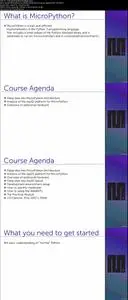MicroPython Complete: The Definitive Guide to Python for Microcontrollers Using MicroPython and ESP32
MP4 | Video: AVC 1280x720 | Audio: AAC 44KHz 2ch | Duration: 1 Hour 48M | 1.12 GB
Genre: eLearning | Language: English
MP4 | Video: AVC 1280x720 | Audio: AAC 44KHz 2ch | Duration: 1 Hour 48M | 1.12 GB
Genre: eLearning | Language: English
Introducing MicroPython. This first topic in the MicroPython Complete course introduces MicroPython, which is a lean and efficient implementation of the Python 3 programming language. MicroPython includes a subset of the Python standard library, and is optimized to run on microcontrollers and in constrained environments.
How MicroPython Works. Develop a stronger grasp of the MicroPython language including its interpretative feature during this second topic in the MicroPython Complete course.
Introducing ESP32. Develop a fundamental knowledge of the ESP32 SoC (System-on-a-Chip) during this third topic in the MicroPython Complete course. Learn about ESP32’s WiFi and Bluetooth connectivity options.
MicroPython Components. Become equipped to use all of the MicroPython components in this fourth topic in the MicroPython Complete course, including ESP32, the breadboard, jumper cables, LEDs, resisters, input devices, buttons, and potentiometers.
ESP32 Architecture. Be able to explain the ESP32’s architecture and function block diagram in this fifth topic in the MicroPython Complete course.
Setting up the MicroPython Development Environment. Accomplish the three steps that must be completed before using MicroPython in this sixth topic in the MicroPython Complete course. This includes setting up Python, burning the ESP32 firmware, and installing uPyCraft.
Using the MicroPython Interpreter. Become proficient with the MicroPython Interpreter in this seventh topic in the MicroPython Complete course.
Using WebREPL in MicroPython. Practice using WebREPL in this eighth topic in the MicroPython Complete course. Access the MicroPython Interpreter using the Python prompt over WiFi, connecting through a browser.
Using Functions from the Machine Package in MicroPython. Practice using functions from the most important MicroPython package, the Machine Package, in this ninth topic in the MicroPython Complete course.
Using Classes from the Machine Package in MicroPython. Practice working with pins in in this tenth topic in the MicroPython Complete course. Use the Pin Class from the Machine Package and practicing turning LEDs on and off.
Using Analog to Digital Converters (ADCs) in MicroPython. Practice working with Analog to Digital Converters (ADCs) using potentiometers in this 11th topic in the MicroPython Complete course.
Using Pulse-width Modulation (PWM) in MicroPython. Practice working with Pulse-width Modulation (PWM) in this 12th topic in the MicroPython Complete course.
Operating a Traffic Light in MicroPython. Apply the techniques from the prior sessions and operate a traffic light in MicroPython, in this 13th topic in the MicroPython Complete course.
Controlling a Robotic Arm in MicroPython. Apply the techniques from the prior sessions and control a robotic arm in MicroPython, in this 14th topic in the MicroPython Complete course.
MicroPython Key Messages. This 15th topic in the MicroPython Complete course summarizes the course and provides you with the key messages of the training. Also learn how to continue learning more about MicroPython.





